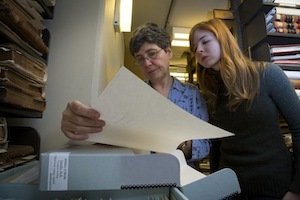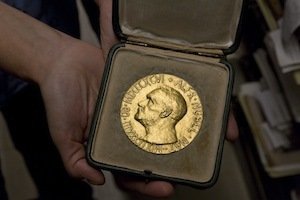McCabe's Lower Level Reveals a Renowned Resource
While McCabe Library may be most familiar to the students whose thesis carrels are found there, it also holds a world-renowned but less wellknown treasure - the Swarthmore College Peace Collection (SCPC). Housed within the lower level and basement of the library is an extensive collection of books, manuscripts, photographs, posters, audiovisual items, bumper stickers, buttons, flags and other ephemera that documents "non-governmental efforts for nonviolent social change, disarmament, and conflict resolution between peoples and nations," according to their mission statement. Established over 80 years ago, the Peace Collection is one of the most extensive research libraries and archive collections in the country that focuses solely on movements for peace.

In 1930, Jane Addams, the prominent internationalist and founder of Hull House in Chicago, visited Swarthmore for the 300th anniversary of the founding of the state of Pennsylvania. During her visit, Addams met with Frank Aydelotte, the president of Swarthmore College from 1921 to 1940 who is famous for implementing the College's Honors Program as well as helping to strengthen its liberal arts education and to elevate the intellectual and student life on campus.
"He was interested in developing a library on internationalism for the students and faculty," says Wendy Chmielewski, the Collection's George R. Cooley Curator. Thoroughly impressed with Aydelotte and the College, Addams bequeathed her extensive collection of personal books on issues of peace and internationalism as a contribution to the library.
The collection, though, had been unofficially developing over the years before Addams' donation, as the College began accumulating records from the Women's International League for Peace and Freedom (WILPF) - an organization of which Addams was the first international president. After Addams became the first U.S. woman to win the Nobel Peace Prize in 1931, the collection began acquiring more and more documents from Addams, including personal letters and even her Nobel Prize medal. The WILPF continued housing all of their records, making it one of the largest collections in the library.
"Since that time, we've probably added three or four thousand more collections, and many thousands more books, photographs, posters, bumper stickers, stamps, political buttons, digital files, and every audio visual format," Chmielewski says. "Every format you can name, we probably have."

The millions of documents and items stored in the collection represent a wide array of peace-related topics, dating back to 1815. "We collect mainly on religious and secular pacifism, disarmament, [the] anti-nuclear movement, conscientious objection, nonviolence, [the] civil rights movement, the anti-Vietnam war [movement] and the current anti-war movement," Chmielewski says. Other main collections include issues of anti-militarism and even a collection of letters written by Mohandas Gandhi.
The collection originated with a strong emphasis on women's rights and women's involvement in the peace movements - an emphasis that is still strong today. "Fifty percent of what we have here is about women's public role, not just in the peace movement, but in social movements in general, from the 19th century onwards," Chmielewski says.
Chmielewski, who has been working at the Peace Collection for what she deems "many, many years," knows the collections, their stories, and the thousands of items like the back of her hand. When she first joined the SCPC, the College had received a grant from the Ford Foundation to organize all the collections on women into a guide, which allowed her to familiarize herself with the many peace organizations founded and fostered by women. As one of the larger collections, the WILPF records include a bevy of documents, photographs, correspondences, publications, and audiovisual aspects that have been collected since 1915. Other women's groups represented in the collection include Code Pink, Women Strike for Peace, the Woman's Peace Party, Another Mother for Peace (a group that opposed the Vietnam war), and the World War II-era Women's Committee to Oppose Conscription.
The collection also highlights individual female peace activists who were involved not only in the woman's suffrage movement, but also in anti-war and anti-nuclear efforts. One such collection is that of Mildred Lisette Norman, better known as Peace Pilgrim, who walked over 25,000 miles across the U.S. promoting global, national, and inner peace. Her papers consist of pamphlets, writings, and news clippings, as well as her tattered shoes, comb, and toothbrush - the few things that Peace Pilgrim carried on her travels.

As the only collection in the country that focuses solely on peace, the SCPC attracts scholars from all over the U.S. and the world, including the United Kingdom, Germany, Japan, France, and Canada. Graduate students use the records for their theses or Ph.D. work, while another portion of the collection's visitors are undergraduates and the general public. The SCPC also maintains a close connection with Swarthmore's Peace and Conflict Studies program (Chmielewski is a member of the program's oversight committee) and provides materials for databases such as the Global Nonviolent Action Database, spearheaded by visiting assistant professor George Lakey and his students.
Another recent use of the Peace Collection's holdings can be found in the work of Duyen Nguyen '13, a Wichita, Kan., native and political science major, and Alison Roseberry-Polier '14, a gender and sexuality studies and history double major from New York City. They dedicated their time last summer to the expansion of an online database that identifies female candidates who ran for office before 1920 - and thus before the 19th Amendment which allowed them to vote was ratified. Called Her Hat Was in the Ring!, the database features biographies for several little-known women involved in the political process of the early 20th century. Their work was supported by Tri-Co Digital Humanities, an initiative committed to discovering and promoting digital literacy and innovating through humanities-based inquiry using new technology.
Though the Peace Collection is mainly utilized for research purposes, it also has its eclectic side, with unique items such as banners from women's suffrage marches, photographs of the Vietnam War, anti-war bumper stickers, a piece of the Soviet missile destroyed in Saryozek in 1988, and even a small portion of the Berlin Wall. The online database, Triptych, provides digitized versions of over 1,700 buttons, pins, and ribbons from peace organizations over the last 130 years, as well as many other items.
The Peace Collection hosts a variety of lectures and exhibits with McCabe Library and the Friends Historical Library, such as last year's exhibit on Bayard Rustin, a peace activist and organizer of the 1963 March on Washington, and a recent lecture about Roy Kepler, founder of Kepler's Books in California and a prominent member of the public radio station KPFA. Chmielewski also hopes to host an event commemorating the upcoming 100th anniversary of WWI.
With its historical treasures and materials, the Peace Collection offers up a distinctive slice of national and international history on peace and social justice.


